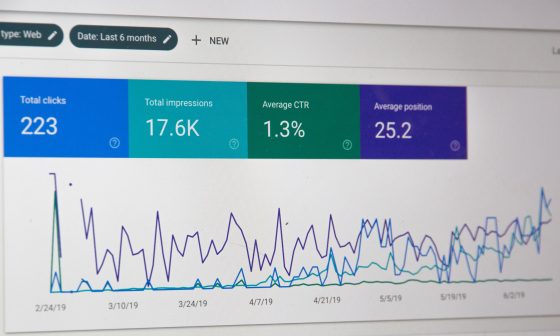Backlinks are the gems of SEO, even in the new world of AI search.
Several reports show a correlation between sites that perform well on search engines and their visibility on LLMs. A recent study by Seer Interactive found that brands that rank on the first page of Google also received more mentions in LLMs.
This means that SEO remains crucial, even as brands strive to optimize their visibility on LLMs. And we cannot discuss SEO without mentioning backlinks. That’s why it’s still essential to monitor backlinks for your clients.
Ultimately, you want to make sure the backlinks your clients have provide value. They should help boost your SEO efforts. This article will cover how to monitor backlinks for SEO. But let’s start with the basics:
What is a backlink monitor?
A backlink monitor is a tool used to track and analyze links pointing to a specific website. It helps sites monitor the quantity and quality of backlinks.
It also helps them identify new backlinks and check changes in their status. A backlink monitor helps assess the overall health of a site’s backlink profile.
Why is backlink monitoring necessary?
Here are four main reasons to invest in monitoring backlinks for SEO:
1. To identify toxic backlinks
Toxic or spammy backlinks refer to hyperlinks from low-quality and spammy websites. They can harm your website’s SEO performance.
Monitoring backlinks helps you determine whether your site is receiving toxic backlinks that could hurt your SEO performance. It allows you to disavow these links before they cause any damage.
2. To track campaign effectiveness
Monitoring backlinks consistently helps you determine whether your link-building efforts have a positive (or negative) impact. This helps you identify the link-building tactics to double down on and the ones to remove from your campaigns.
3. It helps with competitor analysis
You can use backlink monitoring tools to analyze the backlink profiles of different websites. That means you could use them to check the backlink profiles of your client’s competitors. It provides you with key insights, such as the high-quality backlinks they possess that your client doesn’t have.
The research provides valuable insights into what you can do to help your clients level up and outperform their competitors, both on search and LLMs.
4. It helps you identify broken backlinks
Even with a solid link-building strategy, you can still experience broken links. These can result from expired redirects, modifications made to the referring domain page, such as website restructuring, content update or removal, or misspelled or typo-ridden URLs.
With a solid backlink monitoring strategy, you can promptly address your broken backlink issues to boost your SEO performance.
Types of backlinks
All backlinks fall under two primary types: nofollow and dofollow backlinks. Let’s explore them in detail:
Dofollow backlinks
Dofollow links pass link juice from the source domain to your domain. This boosts your site’s credibility, allowing you to rank higher.
You can identify dofollow links by the absence of the “nofollow” attribute in the HTML code of the link.
Nofollow backlinks
These are the opposite of dofollow links because they don’t pass link juice to your site, offering no direct benefit. But this doesn’t mean they’re bad. They’re still an important part of a healthy backlink profile.
Also, a site without nofollow links raises red flags for Google because it’s unrealistic for every referring domain to endorse you.
You can identify a nofollow link with the presence of a “nofollow” tag in the HTML code of the link. Here’s how that looks:
<a href=”https://example.com” rel=”nofollow”>Link Text</a>
You should mark the following types of links as nofollow: paid links from sponsored content, advertisements, and affiliate marketing, plus user-generated content on social media platforms, forums, communities, and websites.
Backlink monitoring tools to use
Here are three top tools used to monitor backlinks:
Majestic SEO
Majestic SEO is a backlink analysis tool that offers real-time insights into your website’s backlink profile. It can index up to 15 years of backlink history.
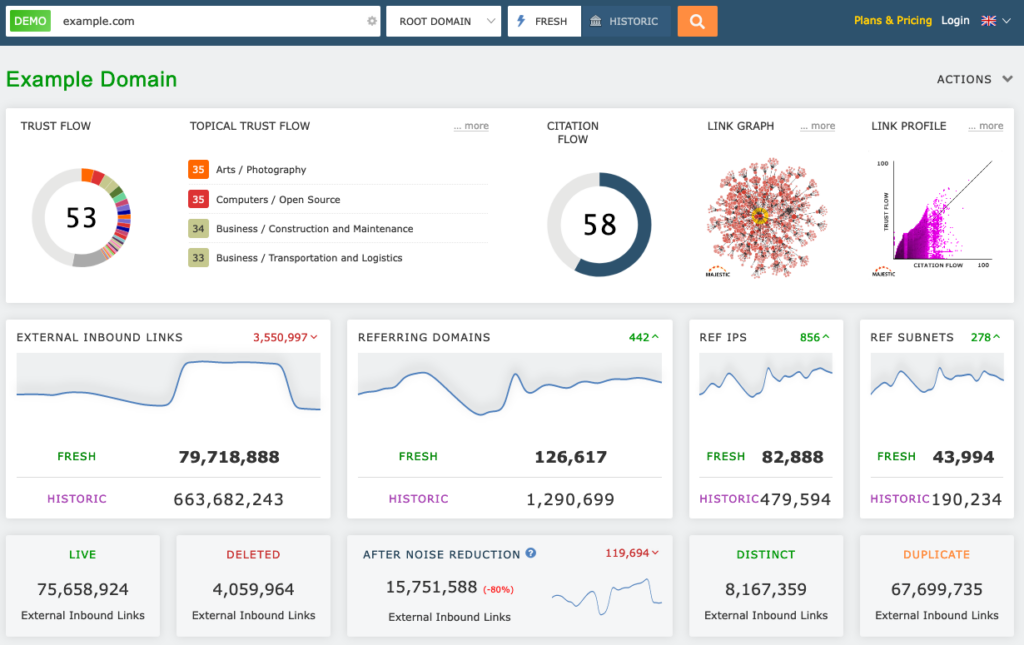
Source: Majestic SEO
Majestic SEO has proprietary trust flow and citation flow features. These measure a site’s trustworthiness and the amount of link juice it can pass to other sites. You can generate customized reports using its API.
Pricing starts at $49 for full API access, with a free demo available.
Semrush
Semrush positions itself as an all-in-one SEO tool. While primarily a keyword research tool, it has some of the best backlink tools available.
Semrush’s authority score is credible because it factors in search traffic instead of just link quantity. Link quantity is subject to manipulation. It also provides detailed dofollow and nofollow links, as well as a toxicity score. You can also get information about lost links and context-based anchor text.
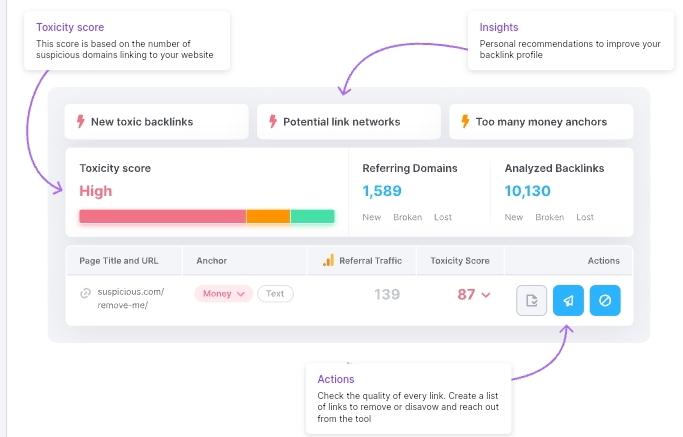
Source: SEMrush
The tool’s free plan offers limited features. The paid account starts at $99 monthly.
Moz
Moz is the oldie in the house. And like Semrush, it’s an all-in-one SEO tool. Its link-to-intersect feature stands out, making it excellent for competitor backlink campaigns.
You can enter up to five competitors’ domains and get a list of websites linking to your competitors but not linking to you. Moz also provides detailed backlink reports with inbound links, anchor text, domain authority, and spam score.
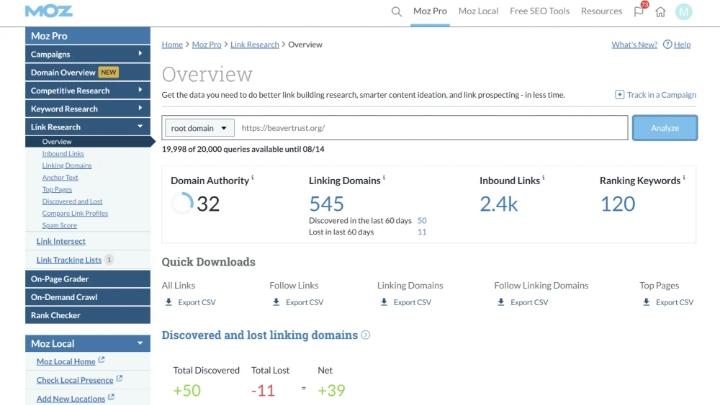
Source: Moz
You can sign up for a free 30-day trial to transition into the limited free plan. The premium plan costs $99 per month.
Best practices to build high-quality backlinks
Now that you understand the importance of evaluating link quality, here are some tips to follow for your backlink assessment.
1. Leverage digital PR
Google may not have endorsed a specific link-building strategy, but here’s what John Mueller has to say about digital PR:

Source: Search Engine Land
If you’re an SEO, then you know Mueller’s words echo the voice of Google. This shows that digital PR should be a priority in your link-building campaign.
Besides boosting performance on search, digital PR is also proving to be a valuable asset in LLM optimization. A great PR strategy helps associate your brand with specific topics that are relevant to your industry. This allows LLMs to start associating your brand with that industry, something that can boost your visibility on these models.
Sentiment analysis is also critical. You want your brand to be mentioned in positive conversations to increase the chances of getting mentioned by an LLM. Use an AI sentiment analysis tool to see what customers have to say about your client and initiate PR campaigns to fix any issues causing negative sentiment.
Digital PR involves crafting compelling press releases or site blog posts about significant company updates, product launches, and noteworthy events. Some of these press releases and blog posts can be published on your own site, while others can be distributed to reputable publications relevant within your industry. For example, Tech Radar for tech-related news.
2. Respond to journalist requests
This requires you to monitor platforms like HARO (Help a Reporter Out) for relevant queries from journalists seeking expert insights or quotes. Responding promptly with valuable insight can earn you a feature and backlink on their publication.
Here’s an example of a HARO request.
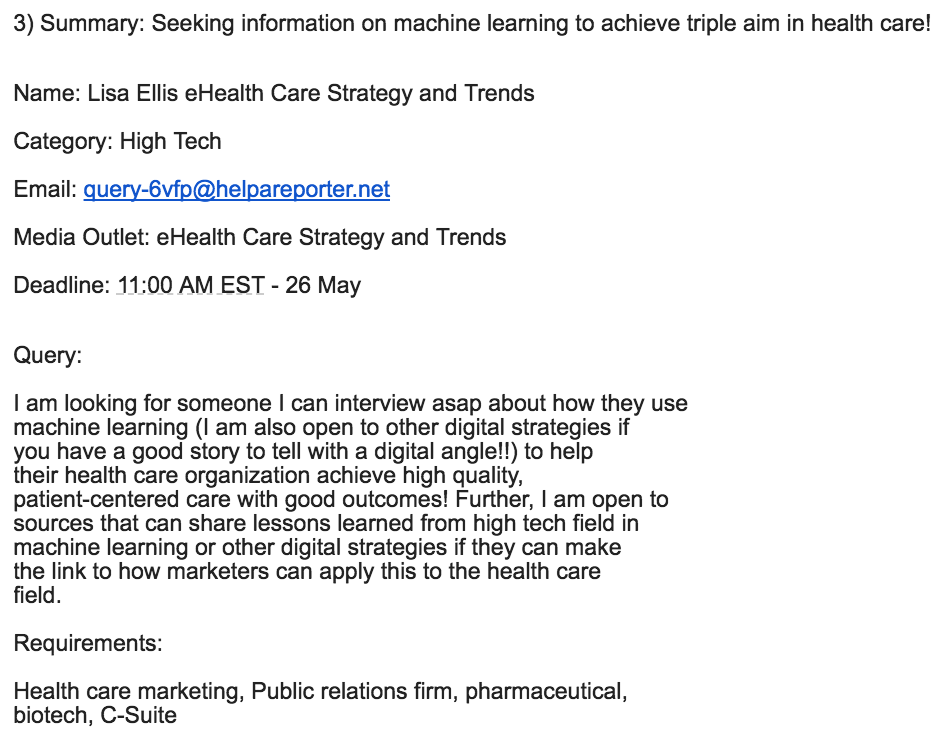
Source: MonkeyLearn
Just make sure your answer is insightful. Also, check the publishing website. Ideally, you want to invest your efforts in publications with a good domain authority, low spam score, and high traffic to get maximum ROI.
3. Create linkable assets
Linkable content assets attract backlinks passively because they provide standalone value. In addition to blog posts and press releases, resources like templates, research reports, and free tools often get cited or shared by others.
For example, the Article Summarizer tool offers a simple way to condense long-form content, making it a useful reference point for content creators. Tools like this naturally earn links from blog posts, newsletters, and forums because they solve a real user problem.

To ensure high-authority sites link to you, identify a core problem in your industry and offer helpful solutions through free linkable assets.
4. Create guest posts on niche sites
To build effective links, target authority niche sites where you can publish high-quality content relevant to their target audience. Be sure to mention your brand and incorporate a link in the guest post.
Though you can do this on your own, you may be able to accelerate the results by partnering with a link-building agency. These agencies already have relationships with most niche websites, which makes it possible to scale high-quality link-building campaigns.
Conclusion
Developing a routine to evaluate your backlinks is key. This will, among other things, enable you to spot vulnerabilities that could expose your site to search engine penalties.
Use tools like Moz, Semrush, and Majestic SEO to track your backlinks and receive notifications for new acquisitions.
Monitoring new backlinks for SEO is crucial, but you can also take a proactive approach by ensuring you’re building high-quality links right from the start. This article has covered four effective strategies you can take to build effective backlinks that will boost your SEO and LLM optimization efforts. Good luck!


